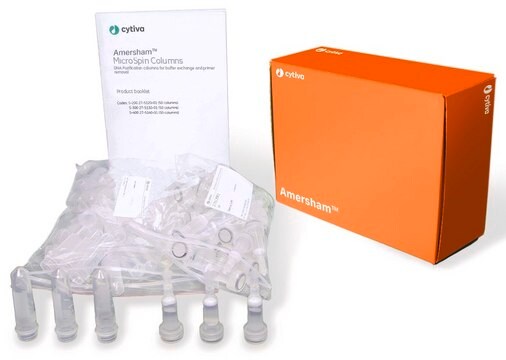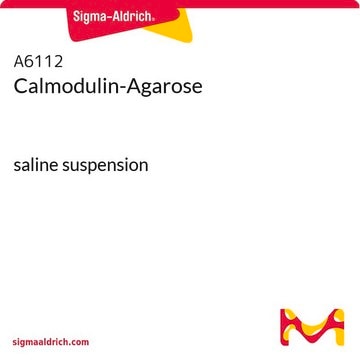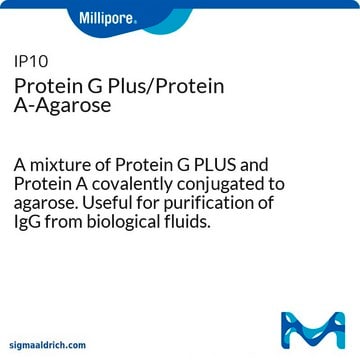U5632
Ubiquitin−Agarose
saline suspension
Se connecterpour consulter vos tarifs contractuels et ceux de votre entreprise/organisme
About This Item
Produits recommandés
Forme
saline suspension
Niveau de qualité
Ampleur du marquage
7-15 mg per mL
Technique(s)
affinity chromatography: suitable
Matrice
Fast flow highly cross-linked 4% beaded agarose
Espaceur de matrice
6 carbon
Température de stockage
2-8°C
Application
Ubiquitin-agarose is used in affinity chromatography, protein chromatography, intracellular protein degradation, calpain and lysosomal proteases, proteomics, specialty resins and ubiquitination analysis. Ubiquitin-agarose has been used in a study to produce evidence for a particulate location of ubiquitin conjugates and ubiquitin-conjugating enzymes in the rabbit brain. Ubiquitin-agarose has also been used to study fertilization of the ascidian, Halocynthia roretzi.
Forme physique
Suspension in 1 M NaCl containing 15 Mm Sodium azide.
Code de la classe de stockage
10 - Combustible liquids
Classe de danger pour l'eau (WGK)
WGK 3
Point d'éclair (°F)
Not applicable
Point d'éclair (°C)
Not applicable
Équipement de protection individuelle
Eyeshields, Gloves
Certificats d'analyse (COA)
Recherchez un Certificats d'analyse (COA) en saisissant le numéro de lot du produit. Les numéros de lot figurent sur l'étiquette du produit après les mots "Lot" ou "Batch".
Déjà en possession de ce produit ?
Retrouvez la documentation relative aux produits que vous avez récemment achetés dans la Bibliothèque de documents.
Anjali Joshi et al.
Traffic (Copenhagen, Denmark), 9(11), 1972-1983 (2008-09-27)
Retroviral Gag polyprotein precursors are both necessary and sufficient for the assembly and release of virus-like particles (VLPs) from infected cells. It is well established that small Gag-encoded motifs, known as late domains, promote particle release by interacting with components
M Majetschak et al.
European journal of biochemistry, 255(2), 482-491 (1998-08-26)
Ubiquitin is often implicated as a specific tag for protein degradation via the ubiquitin system although only a limited number of physiological proteins have been shown to be degraded in their native tissues via this pathway in vivo. Ubiquitin may
A Ciechanover et al.
The Journal of biological chemistry, 257(5), 2537-2542 (1982-03-10)
We have previously described an enzyme that activates ubiquitin, the heat-stable polypeptide of the ATP-dependent proteolytic system from reticulocytes (Ciechanover, A., Heller, H., Katz-Etzion, R., and Hershko, A. (1981) Proc. Natl. Acad. Sci. U. S. A. 78, 761-765). It carries
M Hoefer et al.
FEBS letters, 289(1), 54-58 (1991-09-02)
Ubiquitin-activating enzyme was purified from the yeast Saccharomyces cerevisiae by covalent affinity chromatography on ubiquitin-Sepharose followed by HPLC anion-exchange chromatography. Enzyme activity was monitored by the ubiquitin-dependent ATP: 32PPi exchange assay. The purified enzyme has a specific activity of 1.5
Kristi G Bache et al.
The Journal of biological chemistry, 278(14), 12513-12521 (2003-01-29)
STAM1 and STAM2, which have been identified as regulators of receptor signaling and trafficking, interact directly with Hrs, which mediates the endocytic sorting of ubiquitinated membrane proteins. The STAM proteins interact with the same coiled-coil domain that is involved in
Notre équipe de scientifiques dispose d'une expérience dans tous les secteurs de la recherche, notamment en sciences de la vie, science des matériaux, synthèse chimique, chromatographie, analyse et dans de nombreux autres domaines..
Contacter notre Service technique








